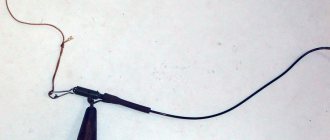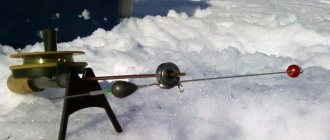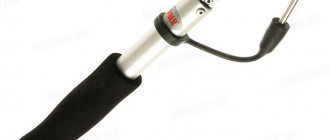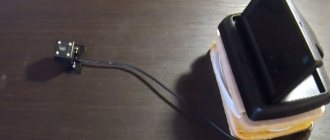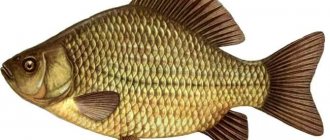What is a “kerchief” for fishing?
“Klondike” is a screen fishing tackle that has a triangular shape. It consists of a metal rod to which a mesh fabric in the shape of an isosceles triangle is attached. At the top of which there is a ring, a rope is tied to it. With its help, the tackle is lowered into the water. The rod plays the role of a sinker, helping to lower the device under water. The mesh cells can have different sizes depending on what kind of fish it is intended for hunting.
To catch small fish, it is enough to install a net with a mesh size of up to 20 mm; for fishing large fish, a net with a mesh size of 50 millimeters or more is suitable. Therefore, the larger the fish you want to catch, the larger the mesh should be, and vice versa.
Is it possible to catch a large specimen in a scarf?
This method is popular among fishermen as a means of catching fry for a reason. You can catch big fish with it, but there are many nuances. First, you need to select a large grid cell. This means there is a high chance of being left without a catch at all. Secondly, the process of waiting for a bite is very tiring. In general, if the goal of fishing is to catch a large fish with a minimum of effort, then this method can be used. But this type of fishing will not bring pleasure.
Large bream on ice
How to use?
Using the fishing kerchief tackle is very simple. A hole is drilled in the ice, the dimensions of which will allow you to lower a metal rod attached to the base of the triangle. They throw food into the hole, which they prepare themselves or buy at a fishing store.
When fishing on the first ice, when the fish has not yet sunk to the bottom and is active, the “kerchief” is lowered closer to the ice surface. The tackle during this period is most catchy. And they do the same closer to spring, then the fish rises to the top, since here the water contains more oxygen.

In the middle of winter, fishing “kerchief” (winter tackle) is not used very often. Cold weather conditions and lack of food force the fish to sink to the bottom of the reservoir, where they can find food in the silt and not freeze.
After the fish is abundantly fed, the “kerchief” is lowered into the hole. It should be checked after a certain period of time. Fishermen who have extensive experience take this device with them every time they go out on the ice. They put a “kerchief”, checking it periodically, and at this time they themselves continue to fish with other gear. The catch in this case will be much richer.
Adviсe
Winter fishing scarves will be an excellent helper for you in catching fish, especially if you take into account useful tips from experienced fishermen:
- Make a hole only if you are sure that there is fish in this place, otherwise you will simply waste time.
- It is advisable to make a mixture for feeding fish yourself, or if you buy it in stores, then only from a trusted manufacturer.
- To fish with scarves in winter, you need to choose places with depressions.
- When you don’t notice the fish’s activity at all, try changing the bait to another one. Perhaps it's her.
- Do not fish when the ice is thin. Many inexperienced fishermen are only happy about this, because making a hole is simple and quick. However, remember that such fishing can end badly for you.
Follow all our tips and you will be happy with a big catch.
Fishing “scarf”: what to make it from
You can make a simple and useful tackle with your own hands.
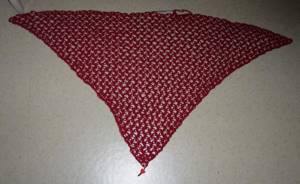
Any fisherman, even a beginner, can make such a device; this will require the following materials:
- fishing mesh with the required mesh size;
- a metal rod or thick wire with a diameter of 5 mm and a length of 1.5 m, which will also serve as a sinker;
- thick fishing line or nylon thread with a diameter of 0.8 mm.
How to make a fishing scarf?
- Lay the fishing net on a flat surface and use scissors to cut out an isosceles triangle with a base equal to the length of the rod or wire.
- Make notches on the metal rod every 20 mm, using a chisel, to firmly attach the blade to the rod.
- Attach the canvas, making a slight slack (without it, the tackle will not work correctly), using fishing line or nylon thread to the metal rod in the places where the notches were made.
- Thread a nylon thread through each cell of the side walls of the triangle. At the top of the triangle, attach a ring to which a rope will be tied to lower it under water.
Fishing technique with a fishing scarf
Use this gear as follows:
- Using the trial method, find where the fish are staying.
- Make bait. For different bodies of water, separate bait is selected. Mixed feeds, grains of any cereal crops, pre-steamed in water, and breadcrumbs are used. Each fisherman selects all this individually, based on his experience, and beginners can consult with experienced fishermen. Successful fishing largely depends on proper feeding.
- The fishing “kerchief” is lowered by the rope into the hole. The end is tied to a stick so that the tackle does not go under water.
- The fish is very shy, so the hole is carefully camouflaged. To do this, put small branches on it and sprinkle it with snow. The sun's rays will not penetrate under water through such a shelter, and the volume of noise will be significantly reduced.
- After 20 minutes, the “kerchief” should be checked; if it is empty, then you need to move it to another hole.
Where and when is the best time to install
When looking for places to fish in the cold season, it is worth considering the limited food supply and water temperature. During the first ice and as spring approaches, you should look for trophies in the reeds and closer to the shore. This is when they are most active as they search for wintering sites. In the middle of winter, fish in schools go to depths, where they remain until the weather warms up. Excellent shelter is sharp drops of the bottom of the reservoir, holes.
Therefore, it is recommended to install the gussets on the bottom. The greatest efficiency is on the first ice and closer to the beginning of spring.
Using this gear in the dead of winter, according to experienced fishermen, is a waste of time. This device is often taken for winter fishing as an auxiliary means of catching fish. Installing them near the holes where they try their luck with a fishing rod.
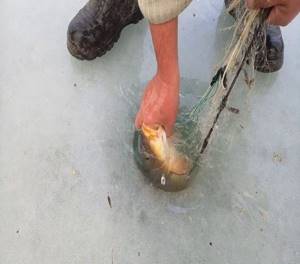
The tackle does not need constant checking. Therefore, fishermen put it in at night or in the morning, and take it out in the evening.
In search of live bait, you can try to fix the scarf in the water column or closer to the surface directly under the hole. Young animals often rise from the depths in search of food or due to lack of oxygen. But before that, you should put the bait mixture into the hole to increase the chances of catching.
Using a “kerchief” to catch fry
One of the best baits for predators is live bait. A fishing scarf is often used for catching small fish (fry). To do this, the network fabric is taken with a small mesh not exceeding 15 mm. Fishing is carried out in the usual way, but you should remember that the fry must remain alive. In this case, it remains on the hook with moving bait for a long time.
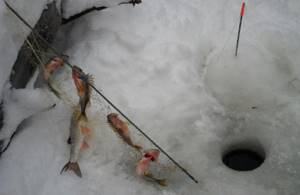
In severe frost, it is better to lift the tackle from the hole together, so as not to freeze the fish that is below, if it is then used as live bait.
Photo of a scarf for winter fishing
Read here Casting net - fishing methods, casting options, application features, pros and cons (120 photos)
Help the project, share on social networks 

0
Specifics of fishing
A fishing scarf is mainly used in fishing as additional equipment. It is perfect for catching live bait (described above). While relaxing in nature, using this simple tackle, you can quickly catch a few fish for your fish soup or for grilling.
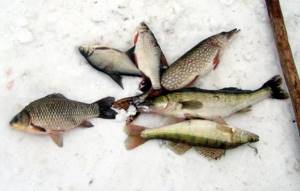
The “kerchief” is also useful for fishing in reservoirs where there is a lot of algae; there they place gear only in small gaps.

